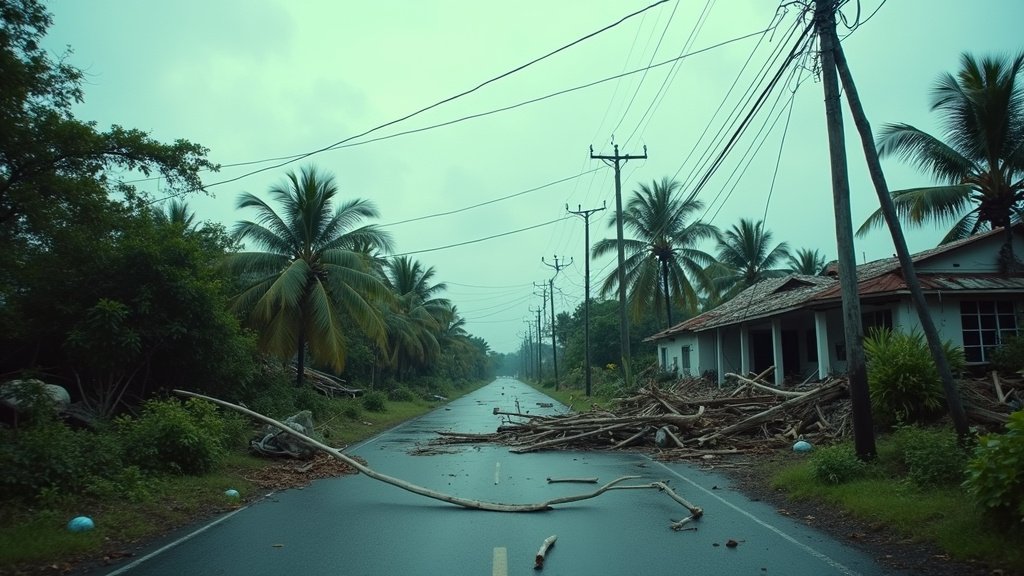Hurricane Beryl Unleashes Fury on Jamaica, Causing Widespread Power Outages and Damage
The powerful Hurricane Beryl battered Jamaica with ferocious winds, torrential rains, and a dangerous storm surge, leaving more than half the island without electricity and causing significant damage to infrastructure. The Category 4 storm, which had previously devastated Grenada and other Caribbean islands as a Category 5, swept across Jamaica on July 3, 2024, prompting widespread power outages and prompting the government to declare the entire island a disaster area.
A Storm of Unprecedented Intensity
Hurricane Beryl made history as the earliest Category 5 hurricane on record in the Atlantic Basin and the strongest July hurricane, reaching peak sustained winds of 165 mph. Before reaching Jamaica, the storm had already caused catastrophic destruction in Grenada, Carriacou, and Petit Martinique, with initial reports indicating approximately 98% of infrastructure destroyed on the smaller islands. Homes were obliterated, trees uprooted, and essential services like desalination plants and cell towers were knocked out. Tragically, at least six deaths were attributed to Beryl across the Caribbean before it made its closest approach to Jamaica.
Jamaica Braces for Impact
As Hurricane Beryl bore down on Jamaica, residents were urged to prepare for life-threatening conditions. Forecasters warned of storm surges reaching up to 9 feet above normal tide levels, accompanied by heavy rainfall and powerful wind gusts that could exceed 150 mph. The storm’s angle of approach meant that the entire island, including the capital city of Kingston, was expected to experience the worst quadrant of the storm. Prime Minister Andrew Holness declared the island a disaster area for seven days and imposed an island-wide curfew, issuing evacuation orders for flood and landslide-prone regions. The U.S. State Department issued a weather alert, advising citizens to seek sturdy shelters and prepare emergency kits.
Widespread Power Outages and Infrastructure Damage
Upon its passage, Hurricane Beryl inflicted considerable damage across Jamaica. The Jamaica Public Service Company (JPS) reported that approximately 60% of its customers initially lost power. Downed utility poles and trees were major contributors to these widespread power outages. Roofs were torn from buildings, including sections of the Norman Manley International Airport in Kingston. Roads became impassable due to fallen trees and debris, hindering emergency response efforts. The restoration of electricity proved to be a protracted challenge, with the JPS announcing the full restoration of power to most customers by August 29, 2024, though some isolated outages persisted due to difficult access and ongoing rebuilding. The disruption to utilities also impacted hotels and villas, leading to guest frustration and highlighting the need for backup power and water systems.
Beyond Jamaica: The Storm’s Continued Path
After impacting Jamaica, Hurricane Beryl continued its westward track toward Mexico’s Yucatan Peninsula, making landfall near Tulum as a Category 2 hurricane with winds of approximately 110 mph. The storm then moved over the Gulf of Mexico, where it re-intensified before making a third and final landfall near Matagorda, Texas, as a hurricane with 90 mph winds on July 8, 2024. The hurricane’s remnants moved northeastward across the United States, eventually dissipating.
The rapid intensification and destructive path of Hurricane Beryl underscore the growing threat of severe weather events, highlighting the vulnerability of island nations and the urgent need for robust preparedness measures and international support for recovery efforts. This headline news serves as a stark reminder of the impact of climate change on meteorological patterns.

